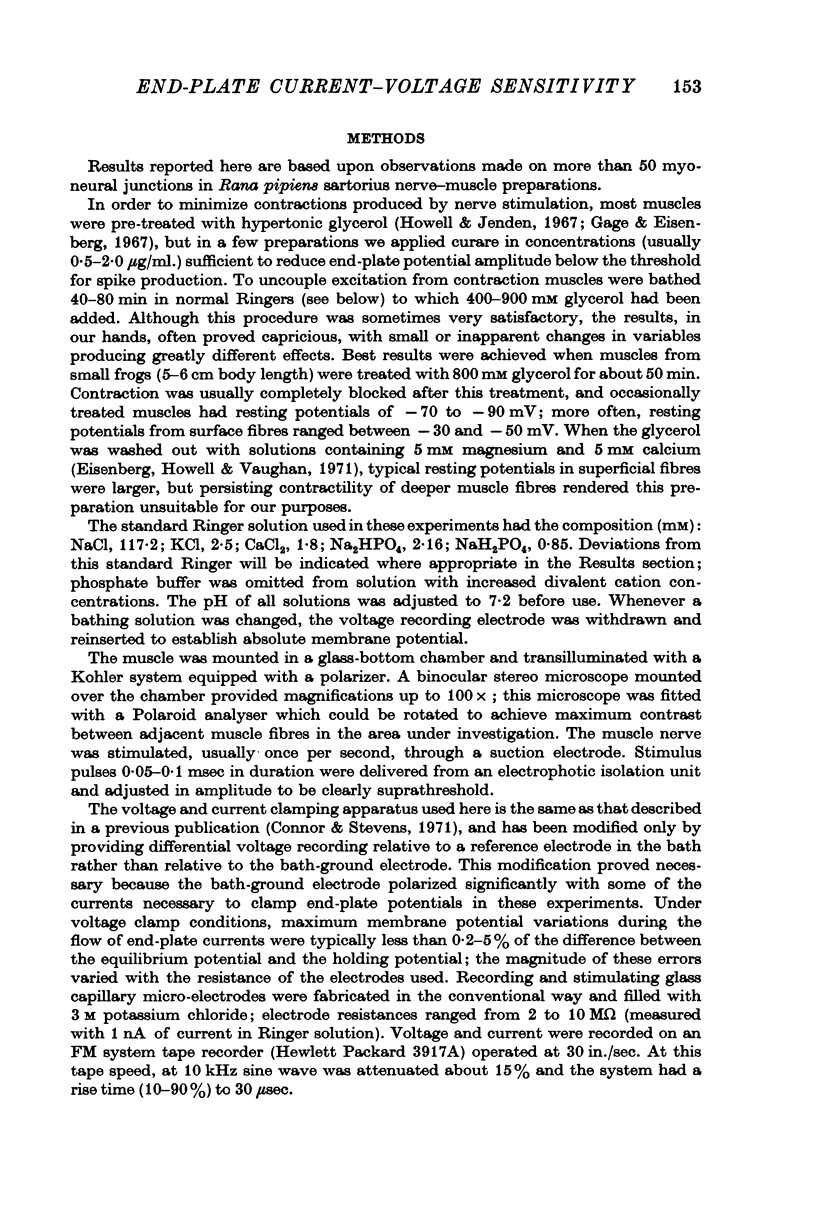Abstract
1. End-plate currents have been studied in glycerol-treated frog sartorius nerve—muscle preparations with the voltage clamp technique.
2. End-plate currents follow a simple exponential time course over most of their declining phase.
3. The rate constant α that characterizes this exponential decay depends upon membrane potential V according to the relationship α (V) = BeAV, with A = 0·00795 ± 0·00043 (S.E.) mV-1 and B = 1·67 ± 0·04 (S.E.) msec-1.
4. Voltage sensitivity decreases (that is, A in the above equation becomes smaller) as the recording and current-passing electrodes are moved away from the end-plate region.
5. The voltage sensitivity of α is decreased by decreasing the gain of the voltage clamp amplifier.
6. Changing the end-plate current amplitude by curare treatment, by increased calcium ion concentration, and by facilitation and depression has essentially no effect on end-plate current time course.
7. When membrane potential is changed step-wise during the decaying phase of the end-plate conductance change, currents begin to decline with a rate constant α appropriate to the new membrane potential in less than 0·2 msec.
8. Treatment with prostigmine methylsulphate in concentrations up to 50 μg/ml. slows end-plate current decay but has little effect on voltage sensitivity. That is, B in the above equation is decreased by prostigmine treatment, but A is relatively unaffected.
Full text
PDF




















Selected References
These references are in PubMed. This may not be the complete list of references from this article.
- Auerbach A., Betz W. Does curare affect transmitter release? J Physiol. 1971 Mar;213(3):691–705. doi: 10.1113/jphysiol.1971.sp009409. [DOI] [PMC free article] [PubMed] [Google Scholar]
- BARRNETT R. J. The fine structural localization of acetylcholinesterase at the myoneural junction. J Cell Biol. 1962 Feb;12:247–262. doi: 10.1083/jcb.12.2.247. [DOI] [PMC free article] [PubMed] [Google Scholar]
- Connor J. A., Stevens C. F. Inward and delayed outward membrane currents in isolated neural somata under voltage clamp. J Physiol. 1971 Feb;213(1):1–19. doi: 10.1113/jphysiol.1971.sp009364. [DOI] [PMC free article] [PubMed] [Google Scholar]
- DEL CASTILLO J., KATZ B. Localization of active spots within the neuromuscular junction of the frog. J Physiol. 1956 Jun 28;132(3):630–649. doi: 10.1113/jphysiol.1956.sp005554. [DOI] [PMC free article] [PubMed] [Google Scholar]
- DEL CASTILLO J., KATZ B. Statistical factors involved in neuromuscular facilitation and depression. J Physiol. 1954 Jun 28;124(3):574–585. doi: 10.1113/jphysiol.1954.sp005130. [DOI] [PMC free article] [PubMed] [Google Scholar]
- Davis R., Koelle G. B. Electron microscopic localization of acetylcholinesterase and nonspecific cholinesterase at the neuromuscular junction by the gold-thiocholine and gold-thiolacetic acid methods. J Cell Biol. 1967 Jul;34(1):157–171. doi: 10.1083/jcb.34.1.157. [DOI] [PMC free article] [PubMed] [Google Scholar]
- Eisenberg R. S., Howell J. N., Vaughan P. C. The maintenance of resting potentials in glycerol-treated muscle fibres. J Physiol. 1971 May;215(1):95–102. doi: 10.1113/jphysiol.1971.sp009459. [DOI] [PMC free article] [PubMed] [Google Scholar]
- Gage P. W., Armstrong C. M. Miniature end-plate currents in voltage-clamped muscle fibre. Nature. 1968 Apr 27;218(5139):363–365. doi: 10.1038/218363b0. [DOI] [PubMed] [Google Scholar]
- Gage P. W., Eisenberg R. S. Action potentials without contraction in frog skeletal muscle fibers with disrupted transverse tubules. Science. 1967 Dec 29;158(3809):1702–1703. doi: 10.1126/science.158.3809.1702. [DOI] [PubMed] [Google Scholar]
- KRNJEVIC K., MITCHELL J. F. The release of acetylcholine in the isolated rat diaphragm. J Physiol. 1961 Feb;155:246–262. doi: 10.1113/jphysiol.1961.sp006625. [DOI] [PMC free article] [PubMed] [Google Scholar]
- KRNJEVIC K., STRAUGHAN D. W. THE RELEASE OF ACETYLCHOLINE FROM THE DENERVATED RAT DIAPHRAGM. J Physiol. 1964 Mar;170:371–378. doi: 10.1113/jphysiol.1964.sp007337. [DOI] [PMC free article] [PubMed] [Google Scholar]
- Kuba K., Tomita T. Effect of prostigmine on the time course of the end-plate potential in the rat diaphragm. J Physiol. 1971 Mar;213(3):533–544. doi: 10.1113/jphysiol.1971.sp009398. [DOI] [PMC free article] [PubMed] [Google Scholar]
- Kuno M., Turkanis S. A., Weakly J. N. Correlation between nerve terminal size and transmitter release at the neuromuscular junction of the frog. J Physiol. 1971 Mar;213(3):545–556. doi: 10.1113/jphysiol.1971.sp009399. [DOI] [PMC free article] [PubMed] [Google Scholar]
- MILEDI R. ELECTRON-MICROSCOPICAL LOCALIZATION OF PRODUCTS FROM HISTOCHEMICAL REACTIONS USED TO DETECT CHOLINESTERASE IN MUSCLE. Nature. 1964 Oct 17;204:293–295. doi: 10.1038/204293b0. [DOI] [PubMed] [Google Scholar]
- Magleby K. L., Stevens C. F. A quantitative description of end-plate currents. J Physiol. 1972 May;223(1):173–197. doi: 10.1113/jphysiol.1972.sp009840. [DOI] [PMC free article] [PubMed] [Google Scholar]
- Mitchell J. F., Silver A. The spontaneous release of acetylcholine from the denervated hemidiaphragm of the rat. J Physiol. 1963 Jan;165(1):117–129. doi: 10.1113/jphysiol.1963.sp007046. [DOI] [PMC free article] [PubMed] [Google Scholar]
- Potter L. T. Synthesis, storage and release of [14C]acetylcholine in isolated rat diaphragm muscles. J Physiol. 1970 Jan;206(1):145–166. doi: 10.1113/jphysiol.1970.sp009003. [DOI] [PMC free article] [PubMed] [Google Scholar]
- TAKEUCHI A., TAKEUCHI N. Active phase of frog's end-plate potential. J Neurophysiol. 1959 Jul;22(4):395–411. doi: 10.1152/jn.1959.22.4.395. [DOI] [PubMed] [Google Scholar]


